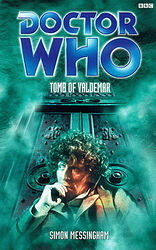
 |  |  |

 | Reviews for Tomb of Valdemar |
|
 |  |  |
There are 5 reviews so far. To add a review of your own for this item, visit the voting page.
| By: | Phil James, UK |
|
| Date: | Saturday 16 November 2002 |
|
| Rating: |    9 9 |
In short - 1st PDA I've read. Excellent prose, intriguing structure, accurate characterisations ofthe Doctor and Romana. Read it in 2 evenings. Good intro to the range. Recognisable, mainstream DW.
| By: | Davros, UK |
|
| Date: | Sunday 24 August 2003 |
|
| Rating: |    1 1 |
Awfull gets worse as it goes on.Pathetic
| By: | Trevor Smith, Nottingham, United Kingdom |
|
| Date: | Sunday 22 March 2009 |
|
| Rating: |    7 7 |
An OK sort of story.
| By: | , |
|
| Date: | Thursday 24 December 2009 |
|
| Rating: |    6 6 |
The central plot is quite allright but the telling of the tale on the ice planet is pretty useless, although in the end everything is tied. The book would have been much better had it concentrated on the main Valdemar story. Also Romana si quite out of character and really annoying!
| By: | David Layton, Los Angeles, United States |
|
| Date: | Sunday 5 November 2017 |
|
| Rating: |    8 8 |
Simon Messingham is definitely one of the more interesting writers of Doctor Who novels. It's the ambition that sets him apart from so many of the others. Tomb of Valdemar is probably his most ambitious Who novel, and for that reason alone most reactions seem to be either love it or hate it. My own feeling is that in this novel Messingham has tried to do too many things and probably should have taken more time than the publishers no doubt gave him to work it all out.
On the level of plot, at least for the main story, there is not really that much unusual. The Doctor and Romana are on their way to track down part 2 of the Key to Time, but get sidetracked by an anomaly onto a deadly planet where a mad cult leader is trying to resurrect an ancient superbeing known as Valdemar. The Doctor is quickly convinced that there is no such thing as Valdemar, but instead there is an ancient gateway or access to some "higher dimensions" that, if let loose, would rewrite the physics of the cosmos. To add to the troubles, the cult leader Neville is an upper-class fugitive from a new workers' revolution, and the ruthlessly dedicated Hopkins, a kind of witch-finder general, is on Neville's trail.
The ambitious part of the novel is the manner of the telling. This is a frame-tale novel in which the main plot is told by someone telling it to someone else. In this case, an old woman identifying herself as one of the chief figures of the adventure, the novelist Pelham, is telling this story to a group of barbarian fur traders on a far away planet. But, she is really telling it to just one fur trader, Ponch, who seems strangely affected by the whole thing. About three quarters of the way through the tale, the old woman dies, and Ponch leaves his life behind to discover the source of his meaningless existence and complete the tale in his own imagination. There are several discussions along the way of this frame tale about the power of storytelling to change people's perceptions, which it seemingly has done for Ponch, who never looks at his world in quite the same way.
One thing that may disturb the reader while going through the story is the level of detail that storyteller Pelham seems to know. There are far too many details that Pelham could not possibly know, especially details about Gallifrey and about what Romana in particular is thinking at any given moment. However, Messingham manages to resolve this problem at the end.
What keeps this novel from meeting its ambition is mainly the difference in quality between the frame story and the inner tale. So, while the attempt seems to be not only to validate the value of storytelling, but also to validate the value of Doctor Who as a storytelling mechanism, an explanation for why so many people keep reading and watching, this message gets undercut by the rather ordinary plot of the inner tale, the only one that the Doctor is actually in. A better Doctor Who story with more direct referentiality to the frame tale would have made the novel's structure more effective in getting across this key message.
Some stray observations: 1) Messingham writes a very good version of Doctor 4, a feat that few other novelists were able to master; 2) As I've said elsewhere, Messingham is very good at writing interior monologue, and quite good at portraying the mental states of deeply disturbed people; 3) The character Redfearn from straight out of two-bit American Westerns has no business being in this novel; 4) There is too much focus on mental powers that can destroy the universe; 5) The villains Neville and Hopkins are too much stock characters, baddies of little particular interest.
So, high marks for the ambition, but some demerits for lack of imagination in some core parts of the novel.


